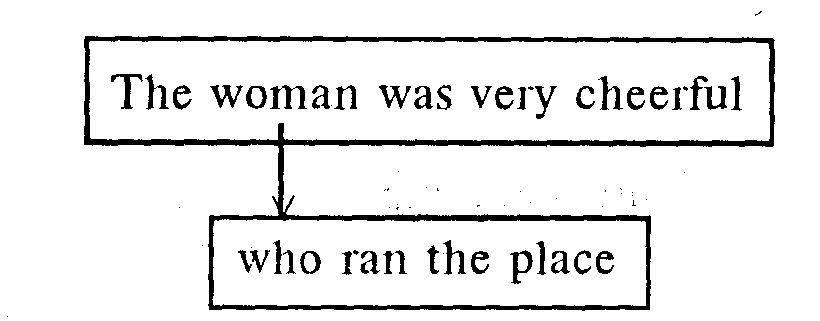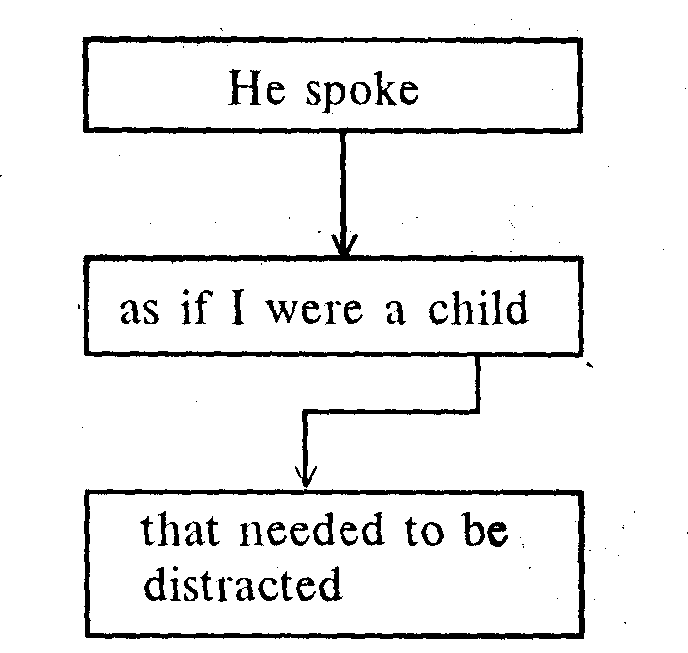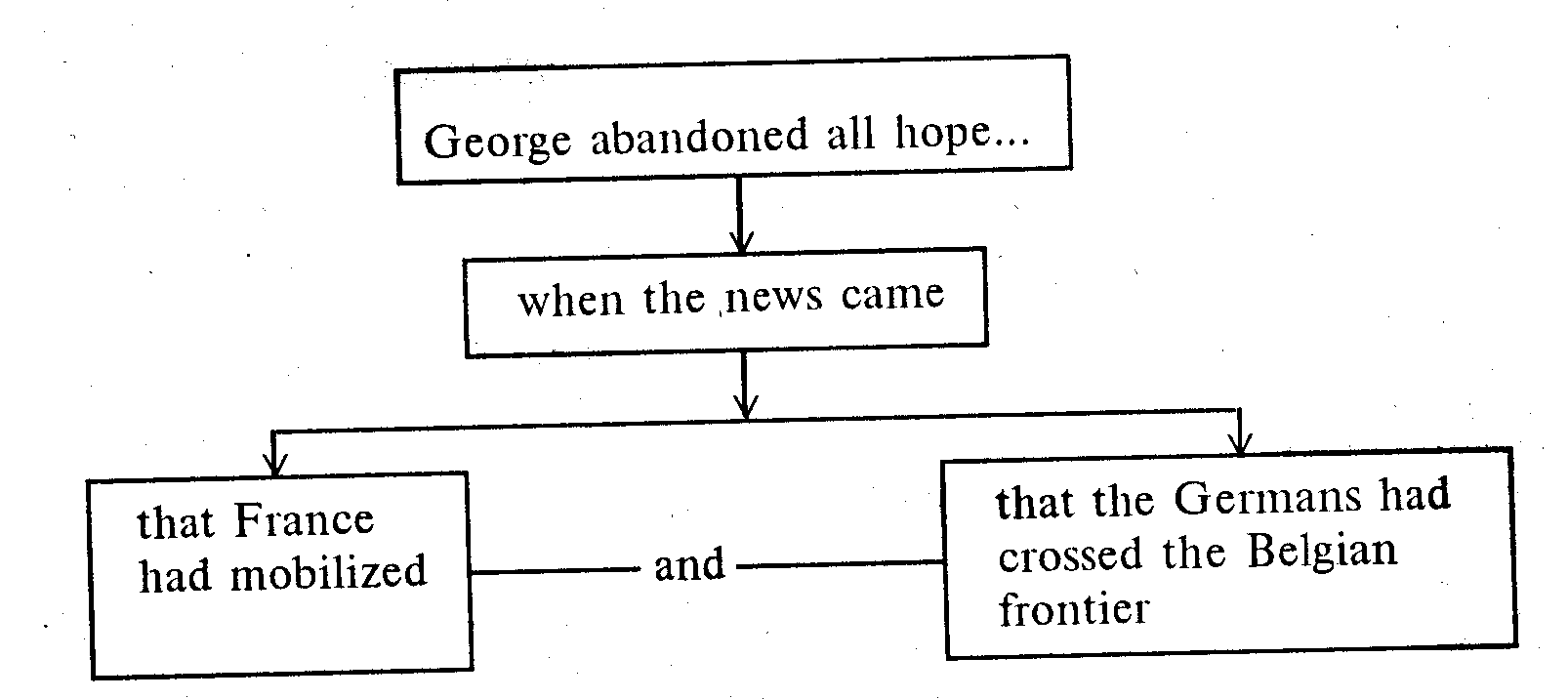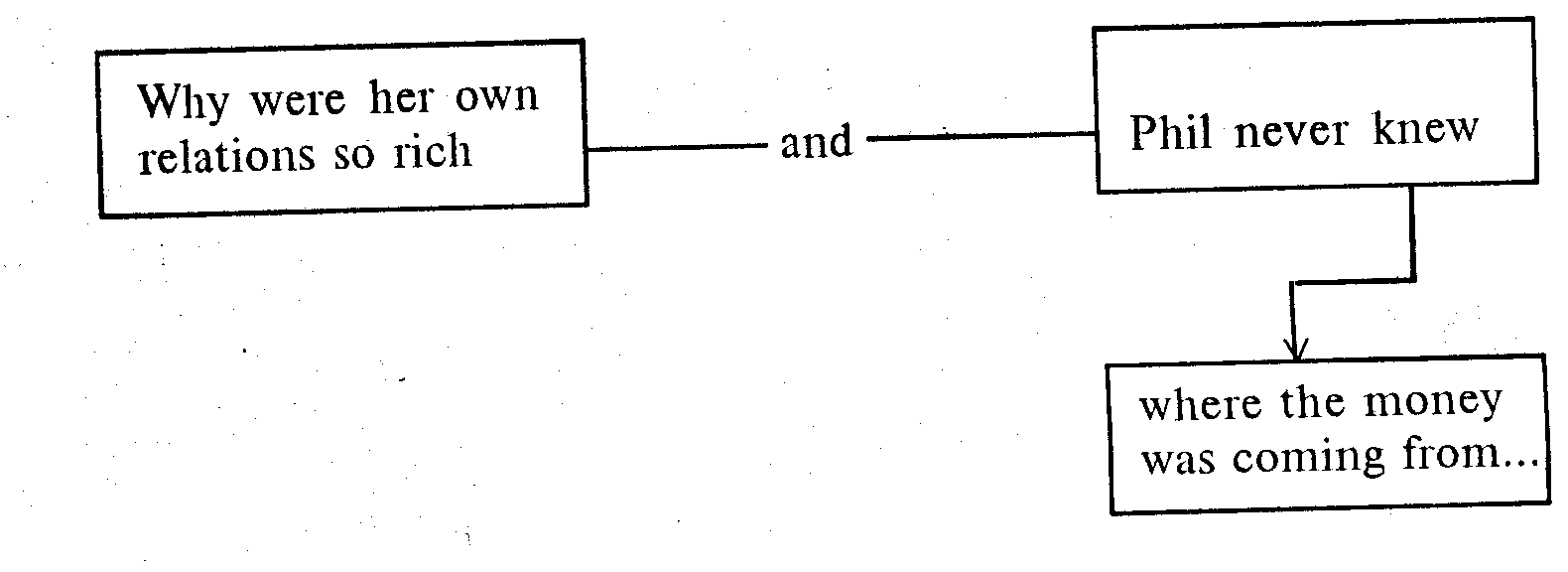Учебник Кобрина. Грамматика. Синтаксис.1999. Учебное пособие для студентов педагогических институтов и университетов по специальности 2103 "Иностранные языки". Спб., Союз, 1999. 496 с
 Скачать 3.61 Mb. Скачать 3.61 Mb.
|
APPENDIX IIISUGGESTED WAYS OF SENTENCE ANALYSISI. The simple sentence 1. Dusk - of a summer night. It is a simple extended one-member declarative sentence. Dusk is the main (principal) part of this sentence. It is expressed by a common noun in the common case. of a summer night is an attribute to the main part. It is expressed by a prepositional phrase. 2. Stop talking! It is an imperative exclamatory sentence. Stop talking is the predicate. It is a compound phasal verbal predicate. It consists of two parts. The first part is expressed by the phasal verb stop in the imperative mood. It denotes the end of the action. The second part is expressed by a non-perfect gerund active denoting the action itself. 3. Could’ve been professional. It is a simple unextended two-member elliptical declarative sentence. The position of the subject is not filled with a word form. Could’ve been professional is the predicate. It is a mixed type of predicate. Could is the modal part expressed by the verb can in the subjunctive mood. It denotes a possibility referring to the past. have been is a link-verb expressed by a perfect infinitive. It is a link-verb of being. professional is a predicative expressed by an adjective in the positive degree. 4. Old Jolyon watching from his corner saw his brother’s face change. It is a simple, extended, two-member sentence. Jolyon is the subject expressed by a proper noun in the common case. Old is an attribute to the subject. It is expressed by an adjective in the positive degree. watching from his corner is an attribute to the subject (or an adverbial modifier of time) expressed by a participial phrase with participle I as headword. saw is the predicate. It is a simple verbal predicate expressed by the verb to see in the past indefinite active. his brother’s face change is a complex object expressed by an objective with the infinitive construction; it consists of a nominal phrase (his brother’s face) and a non-perfect infinitive. Note: Verbal and non-verbal complexes are to be treated as one indivisible part of the sentence. 5. Is the weather not likely to change? It is a simple unextended two-member interrogative sentence. the weather is the subject expressed by a common noun. in the common case. Is not likely to change is the predicate. It is a compound verbal predicate of double orientation. It consists of two parts. Is not likely is the first part. It denotes the estimate of the speaker of, or his attitude to, the situation described in the sentence. It is expressed by a phrase with a modal meaning. to change is the second part. It denotes the action itself and is expressed by a non-perfect infinitive. 6. The whole house being made of wood, it looked good. It is a simple extended two-member declarative sentence. it is the subject expressed by a personal pronoun of the 3rd person singular. looked good is the predicate. It is a compound nominal predicate, consisting of a link verb and a predicative. looked is a link verb expressed by the past indefinite of the link verb to look, which is a link verb of being in a state. the whole house being made of wood is an adverbial modifier of reason expressed by a nominative absolute participial construction. 7. I found my life dull. It is a simple extended two-member declarative sentence. I is the subject expressed by a personal pronoun of the 1st person singular. found is a simple verbal predicate expressed by the past indefinite of the verb to find. my life dull is a predicative complex (or a complex object) expressed by an objective non-verbal construction (or by an object + objective predicative). II. The composite sentence A. The compound sentence 1. (a) Coffee was served and the ladies went upstairs. It is a compound sentence consisting of two coordinate clauses connected by copulative connection with the help of the conjunction and.
(b) He loved his work and he counted himself fortunate to have such an opportunity so early in his career. It is a compound sentence containing two clauses joined by causative-consecutive relations with the help of the copulative conjunction and, which expresses a shade of consecutive relations. (c) I wanted to go on, whereas my friend wanted to go back. It is a compound sentence comprising two coordinate clauses which are connected by adversative connection expressed by the adversative conjunction whereas. In sentences (b), (c) the graphical presentation is the same as in sentence (a). 2. (a) Our Elsie was looking at her with big imploring eyes; she was frowning, she wanted to go. It is a compound sentence consisting of three coordinate clauses which are connected by copulative coordination asyndetically.
(b) I longed to stay there and tell the truth, but that would have been ridiculous, so I came away. It is a compound sentence comprising three coordinate clauses. The first two clauses are joined by means of adversative connection with the help of the adversative conjunction but. The second and the third clauses are connected by causative-consecutive connection with the help of the consecutive conjunction so.
B. The complex sentence 1. (a) What impressed me was Cyprus Avenue. It is a complex sentence with the subject expressed by a subordinate clause introduced by the conjunctive pronoun what. The main clause is devoid of the subject.
(b) This is where Havoc Has been. It is a complex sentence with a predicative clause introduced by the conjunctive adverb where. The main clause is devoid of the predicative.
(c) What surprised him was that there was no pain about it. It is a complex sentence with a subject and a predicative clause. The subject clause is introduced by the conjunctive pronoun what and the predicative clause by the conjunction that. Since these clauses occupy the positions of the main parts of the sentence, the main (principal) clause is reduced to the link verb only.
2. (a) The woman who ran the place was very cheerful. It is a complex sentence comprising (or consisting of) two clauses. The main clause is The woman was very cheerful. The subordinate clause is who ran the place. It is a restrictive (limiting) relative attributive clause modifying the subject of the main clause as its antecedent.  The same graphical presentation is to be found in other complex sentences containing one subordinate clause. (b) The next book she wrote she sent to a magazine. It is a complex sentence with a contact clause dependent on the antecedent the next book, which is the subject of the main clause. Or: It is a complex sentence containing a restrictive attributive clause joined to the main clause asyndetically. (c) Stratford-on-Avon, -where Shakespeare was born, is visited by thousands of tourists. It is a complex sentence with a descriptive (or non-restrictive) attributive clause introduced by the relative adverb where, which refers to the antecedent Stratford-on-Avon in the main clause. (d) Look before you leap. It is a complex sentence with an adverbial clause of time introduced by the conjunction before and depending on-the predicate of the main clause. (e) Bad as things are, we mustn’t give up hope. It is a complex sentence with an adverbial clause of concession. The concessive clause is introduced by the conjunction as with inverted word order in the subordinate clause. It modifies the whole of the main clause. 3. I did not tell Muriel on my return to London what George had said to me, or what he looked like, but contended myself with assuring her that he was well and happy. It is a complex sentence comprising one main clause and three subordinate object clauses. The main clause contains two homogeneous predicates (did not tell and contended) connected by the conjunction but. The first and the second subordinate clauses are homogeneous, they are joined to each other by the disjunctive conjunction or and introduced by the conjunctive pronoun what. Both modify the first of the two homogeneous predicates. The third object clause is introduced by the conjunction that. It depends on the object to the second homogeneous predicate with assuring.  (а) Не spoke as if I were a child that needed to be distracted. It is a complex sentence comprising three clauses. (Or: it is a complex sentence consisting of the main clause He spoke and two subordinate clauses of different degrees of subordination.) The first subordinate clause is of the first degree of subordination. It is an adverbial clause of comparison introduced by the conjunction as if and depending on the predicate of the main clause. The second subordinate clause is of the second degree of subordination. It is a restrictive attributive clause introduced by the relative pronoun that and depending on the predicative of the previous clause, that is, the clause of the first degree of subordination.  (b) When the news came that France had mobilized and that the Germans had crossed the Belgian frontier, George abandoned all hope immediately. It is a complex sentence consisting of one principal and three subordinate clauses. The first subordinate clause is introduced by the conjunction when and is a subordinate clause of time of the first degree of subordination. The other two clauses are of the second degree of subordination. They are homogeneous appositive clauses introduced by the conjunction that and linked with each other by the copulative conjunction and. They both depend on the subject of the adverbial clause of time.  С. The compound-complex sentence Why were her own relations so rich, and Phil never knew where the money was coming from for tomorrow’s tobacco? It is a compound-complex sentence consisting of two coordinated clauses connected by contrasting relations and linked by the copulative conjunction and. Besides two coordinate clauses the sentence comprises one subordinate clause which depends on the second coordinate clause. It is an object clause introduced by the conjunctive adverb where.  SUPPLEMENT Tense Auxiliaries As the majority of the finite form of the verb are analytical they are formed by means of auxiliary verbs (auxiliaries). These are: to do, to be, to have, shall, will. In the spoken language some forms of the auxiliaries and the negation not are contracted which is shown in writing by means of the apostrophe (‘)  Note: In the spoken language is [ɪz] is usually weakened and is pronounced [z] after vowels and voiced consonants (except voiced sibilants and affricates), [s] after voiceless consonants (except voiceless sibilants and affricates), [ǝz] after sibilants and affricates (both voiced and voiceless). This weakening of the form is not usually shown in writing: The boy is gone (ðǝ 'boɪz'gon]. The plan is good [ðǝ 'plænz'gud]. The cup is broken [ðǝ 'kʌps'broukæn]. The bus is coming up [ðǝ 'bʌsǝz'kʌmɪŋ'ʌp]. * The contraction of are combined with certain personal pronouns is pronounced differently is British and American English, viz.:
** In dialect and "uneducated" British and American English the form ain’t is very common. It is used as a contracted form of am not, are not, is not, have not and has not. Ain’t is not used in standard (“correct”) English. . I ain’t going to buy it. Don’t talk to me like that, you ain’t my mother. It ain’t raining, let’s go out. I ain’t got any money. He ain’t seen me yet. ** ‘m not is replaced by aren’t in the negative-interrogative (Aren’t I clever enough? I’m clever enough, aren’t I?)   Note: As a future tense auxiliary shall (should) is used with the 1st person (singular and plural) only.  Note 1: As a future tense auxiliary will (would) in its full form is commonly used with the 2nd and the 3rd persons. Nowadays however there is strong tendency to use it with the 1st persons as well, especially in American English. Note 2: The contractions ‘ll and ‘d stand for will and would, not for shall and should, though they are widely used with the 1st persons as well. Archaic Forms of the Auxiliaries The forms given in the tables above are those of modern standard English. One may also come across archaic forms, mainly in poetry or texts where an archaic effect is intended.
|

